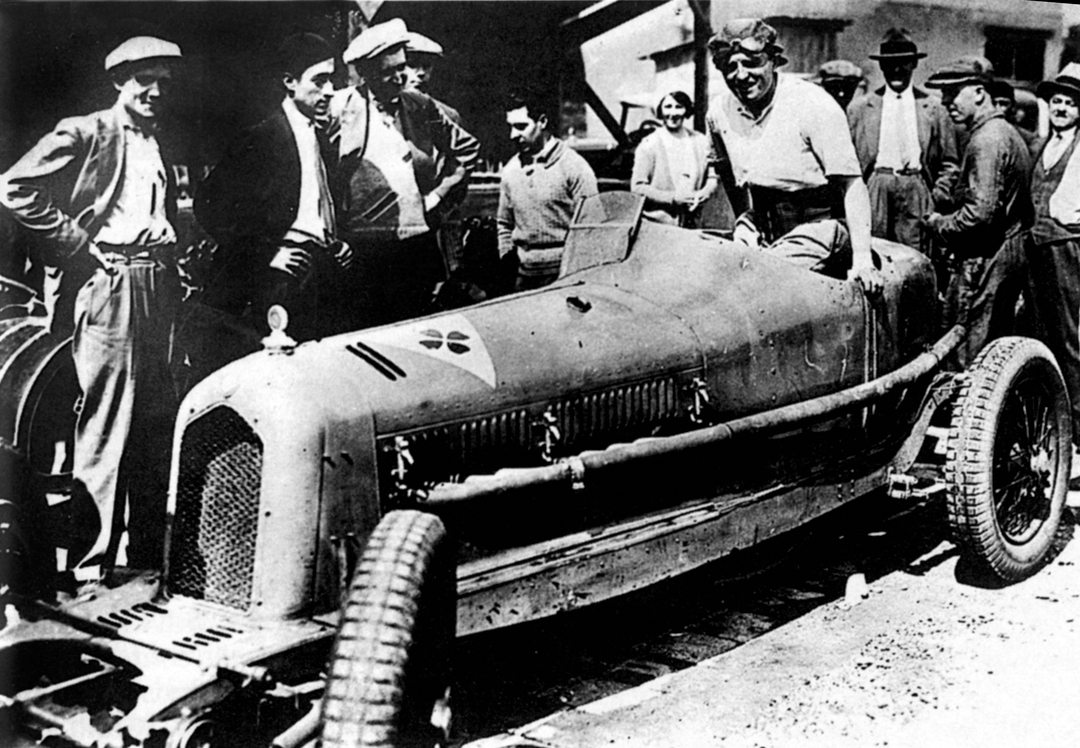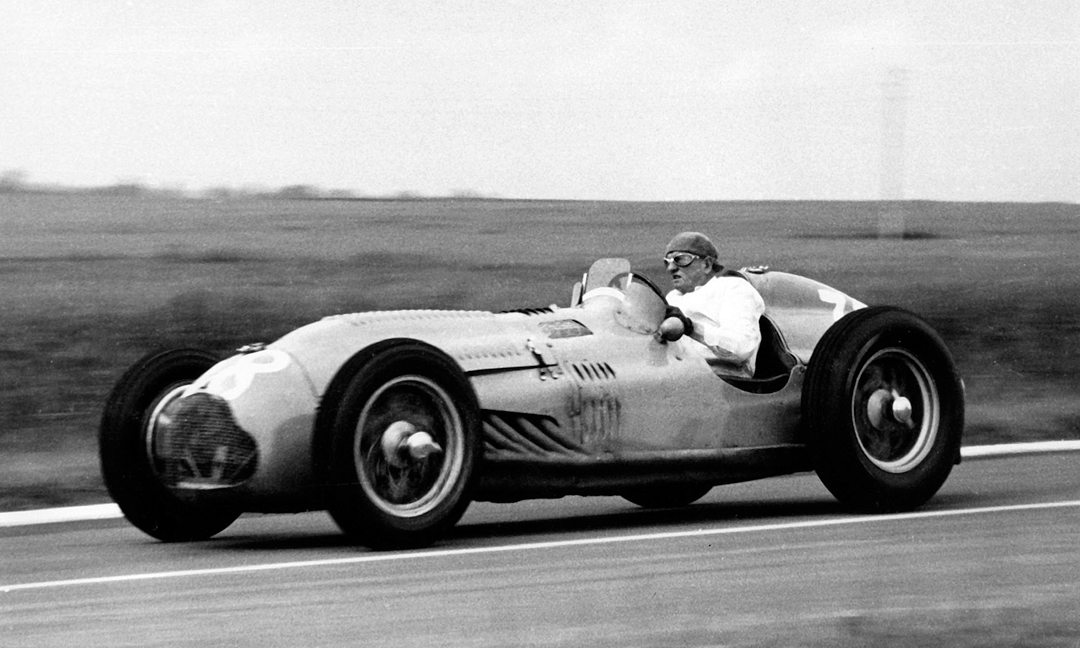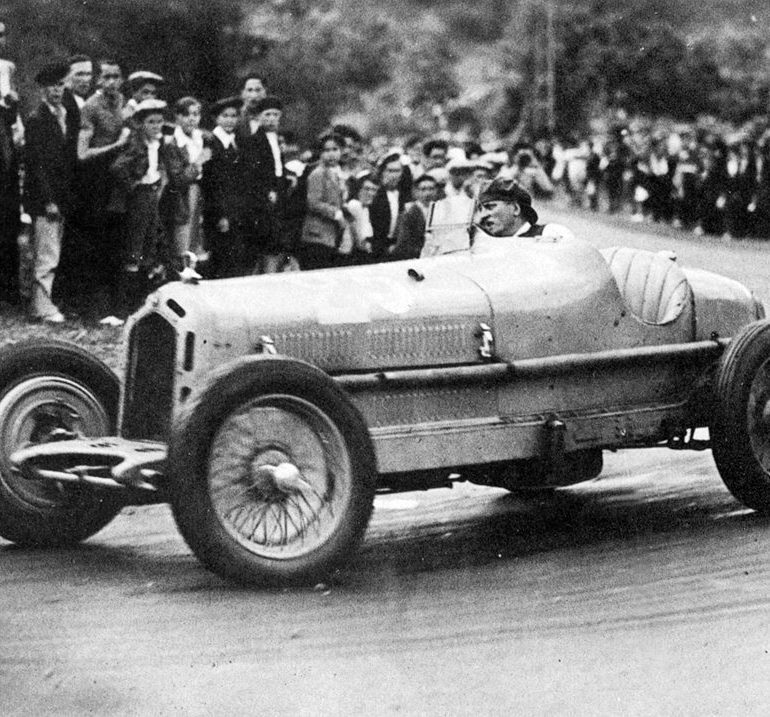If you ever see a photograph of Philippe Etancelin in action, chances are you will never forget him. Because he’s the one who raced cars wearing his cap back to front.
Phi Phi, as Etancelin was nicknamed, was one of those monied gentleman drivers, a wool merchant who loved to race. But unlike some of his kind, he was skillful and fiercely competitive. He won 16 Grands Prix, some of them, admittedly, were lesser events, but others included absolute top liners such as the Grand Prix of France and the 24 Hours of Le Mans. Philippe could muster all the skill and aggression of a top professional when it was called for, as confirmed by his nine-lap, wheel-to-wheel battle in an Alfa Monza with the hyper-tenacious Tazio Nuvolari’s Maserati 8CM during the 1933 Grand Prix of Nice. But Philippe’s list of victories is less crowded than it might have been, because he took his business commitments seriously and even stopped racing for a year to fulfill them.
Born in Rouen, France, in 1896 to a wealthy family that had made its fortune in the wool industry, Phi Phi began racing a Bugatti T35B in minor events when he was 20 years old. He had his first big success in 1927, when he won the Grand Prix de la Marne and established himself as one of France’s fastest racing drivers. Philippe bought a T35C in 1929 and literally cleaned up in the Marne again, the Reims, Comminges, and La Baule GPs. He scored one of his two most important victories in 1930, when he won the Grand Prix of France at Pau, beating drivers of the caliber of William Grover Williams and Sir “Tim” Birkin. He also won the GPs of Grenoble and St. Raphael that year.
When Alfa Romeo decided it was ready to sell its Monzas to private entrants, Philippe was the first in line and had his new 8C painted an uncharacteristic French racing blue. He campaigned the car to good effect, winning the Grands Prix of Grenoble and Comminges again, the Dieppe and the Circuit du Dauphine. Then, the Alfa P3 exploded onto the scene and just about no racecar was safe from its speed and agility including the Monzas, although Etancelin did manage to win at Peronne with his car once more.

Photo: Alfa Archive
In 1933, Phi Phi ran his Monza for the third successive year to win at the Grands Prix of Reims and Peronne plus the GPs de Picardie and de la Marne—and he nearly turned motor racing on its ear during the season’s Grand Prix of France at Montlhéry, where he was about to win the race from Italian ace Giuseppe Campari and the Italian’s rather outdated Maserati 8C 3000. But with Philippe firmly in the lead, on the 39th of 40 laps, the Monza’s clutch started playing up and that slowed the blue Alfa sufficiently to allow Campari to pass him and take the win. Even so, Phi Phi still hung on and managed to finish 2nd, ahead of distinguished racers of the day George Eyston, Raymond Sommer, and Algerian tearaway Guy Moll.
Etancelin was quite a problem for Scuderia Ferrari in 1934, as Maranello had decided not to compete against the all-conquering Mercedes-Benz and Auto Unions at each European championship Grand Prix, but to pick up easier money in lesser events. Because Philippe had acquired a Maserati 8CM, he was the one who gave the Scuderia some stiff opposition that season: Those smaller events were not as easy as Ferrari had hoped, and the Frenchman scored a string of high placings and even beat the Scuderia’s P3s to win the Grand Prix of Dieppe.
But Etancelin didn’t cut his ties with Alfa completely. He was another talented driver who joined forces with Scuderia Ferrari’s long-distance specialist Luigi Chinetti—Louis Chiron did so in 1933 and won the 24 Hours of Spa with the Italian—to win the 1934 24 Hours of Le Mans and the 2,001-3,000-cc class of the French classic in an Alfa 8C. And it wasn’t Chinetti who set the race’s fastest lap; it was Philippe with a time of 5 mins 41 secs for the 8.378-mile circuit.
A year later, Phi Phi raced two different Maseratis, both of which were outclassed. One was a 6C-34 belonging to Carlo Felice Trossi’s Scuderia Subalpina, in which Etancelin could only manage a 4th at Monaco. The other was his own new Maserati V8R1, which he drove into 3rd place and onto the podium of the Grand Prix of Tunis, a counter toward the European championship. His only win of the year was in the V8R1 at the Grand Prix of Pau.

Etancelin did not race at all in 1937, but devoted himself to his wool business. He did compete in a 4.5-liter Talbot-Lago in 1938–’39, but was unceremoniously elbowed aside by the German juggernaut. The best he and the Talbot could do was to take 3rd place in the Grand Prix of Pau, behind the Mercedes-Benz of winner Hermann Lang and 2nd place Manfred von Brauchitsch.
After the Second World War, Philippe became the first driver to race an Alfa Romeo when he bought an old Monza with which to compete in the symbolic 1945 Bois de Boulogne races, French motor racing’s way of saluting peace.
There were some undistinguished outings in a Maserati and a Delage until 1948, when Phi Phi acquired one of the new Talbot-Lago 26Cs and campaigned that for the next four years. At well over 50 years old, he was still able to put up a fight: He scored some creditable placings and actually won the 1949 Grand Prix of Paris at Montlhéry. But his finest hour that year came in the Grand Prix of Italy at Monza, where he gave Alberto Ascari and his Ferrari 125 a really hard time in an effort to snatch the lead away from the Italian. In the end, Phi Phi had to settle for 2nd, ahead of Prince Bira, Tullo de Graffenried, and Raymond Sommer.
In 1953, when he was 56 years old, Philippe retired from motor racing and was awarded the Légion d’Honneur. He became a regular at the meetings of the Anciens Pilote retired-racing-drivers’ club until his death, aged 81, at his home in the exclusive Neuilly-sur-Seine, near Paris, on October 13, 1981.




